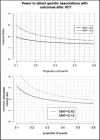Identification and utilization of donor and recipient genetic variants to predict survival after HCT: are we ready for primetime?
- PMID: 25700678
- PMCID: PMC4352187
- DOI: 10.1007/s11899-014-0246-x
Identification and utilization of donor and recipient genetic variants to predict survival after HCT: are we ready for primetime?
Abstract
Overall survival following hematopoietic cell transplantation (HCT) has improved over the past two decades through better patient selection and advances in HLA typing, supportive care, and infection prophylaxis. Nonetheless, mortality rates are still unsatisfactory and transplant-related mortality remains a major cause of death after unrelated allogeneic HCT. Since there are no known pre-HCT, non-HLA biologic predictors of survival following transplant, for over a decade, scientists have been investigating the role of non-HLA germline genetic variation in survival and treatment-related mortality after HCT. Variation in single nucleotide polymorphisms (SNPs) has the potential to impact chemotherapy, radiation, and immune responses, leading to different post-HCT survival outcomes. In this paper, we address the current knowledge of the contribution of genetic variation to survival following HCT and discuss study design and methodology for investigating HCT survival on a genomic scale.
Conflict of interest statement
Dr. Lara E. Sucheston-Campbell, Dr. Alyssa Clay, Dr. Philip L. McCarthy, Dr. Qianqian Zhu, Dr. Leah Preus, Dr. Marcelo Pasquini, Dr. Kenan Onel, and Dr. Theresa Hahn each declare no potential conflicts of interest.
Figures

Similar articles
-
Alloreactivity as therapeutic principle in the treatment of hematologic malignancies. Studies of clinical and immunologic aspects of allogeneic hematopoietic cell transplantation with nonmyeloablative conditioning.Dan Med Bull. 2007 May;54(2):112-39. Dan Med Bull. 2007. PMID: 17521527 Review.
-
Genomic polymorphism and allogeneic hematopoietic transplantation outcome.Biol Blood Marrow Transplant. 2006 Jan;12(1 Suppl 1):19-27. doi: 10.1016/j.bbmt.2005.09.014. Biol Blood Marrow Transplant. 2006. PMID: 16399580 Review.
-
Donor selection for killer immunoglobulin-like receptors B haplotype of the centromeric motifs can improve the outcome after HLA-identical sibling hematopoietic stem cell transplantation.Biol Blood Marrow Transplant. 2014 Jan;20(1):98-105. Biol Blood Marrow Transplant. 2014. PMID: 24516895
-
The effect of KIR ligand incompatibility on the outcome of unrelated donor transplantation: a report from the center for international blood and marrow transplant research, the European blood and marrow transplant registry, and the Dutch registry.Biol Blood Marrow Transplant. 2006 Aug;12(8):876-84. doi: 10.1016/j.bbmt.2006.05.007. Biol Blood Marrow Transplant. 2006. PMID: 16864058
-
KIR ligands and prediction of relapse after unrelated donor hematopoietic cell transplantation for hematologic malignancy.Biol Blood Marrow Transplant. 2006 Aug;12(8):828-36. doi: 10.1016/j.bbmt.2006.04.008. Biol Blood Marrow Transplant. 2006. PMID: 16864053 Clinical Trial.
Cited by
-
Genetic association with B-cell acute lymphoblastic leukemia in allogeneic transplant patients differs by age and sex.Blood Adv. 2017 Sep 8;1(20):1717-1728. doi: 10.1182/bloodadvances.2017006023. eCollection 2017 Sep 12. Blood Adv. 2017. PMID: 29296818 Free PMC article.
-
Pre-HCT mosaicism increases relapse risk and lowers survival in acute lymphoblastic leukemia patients post-unrelated HCT.Blood Adv. 2021 Jan 12;5(1):66-70. doi: 10.1182/bloodadvances.2020003366. Blood Adv. 2021. PMID: 33570634 Free PMC article.
-
Integrating somatic variant data and biomarkers for germline variant classification in cancer predisposition genes.Hum Mutat. 2018 Nov;39(11):1542-1552. doi: 10.1002/humu.23640. Hum Mutat. 2018. PMID: 30311369 Free PMC article.
-
Replication and validation of genetic polymorphisms associated with survival after allogeneic blood or marrow transplant.Blood. 2017 Sep 28;130(13):1585-1596. doi: 10.1182/blood-2017-05-784637. Epub 2017 Aug 15. Blood. 2017. PMID: 28811306 Free PMC article.
-
Replication of associations between genetic polymorphisms and chronic graft-versus-host disease.Blood. 2016 Nov 17;128(20):2450-2456. doi: 10.1182/blood-2016-07-728063. Epub 2016 Oct 6. Blood. 2016. PMID: 27758874 Free PMC article.
References
-
- Spellman S, Setterholm M, Maiers M, Noreen H, Oudshoorn M, Fernandez-Vina M, et al. Advances in the selection of HLA-compatible donors: refinements in HLA typing and matching over the first 20 years of the National Marrow Donor Program Registry. Biol Blood Marrow Transplant J Am Soc Blood Marrow Transplant. 2008;14(9 Suppl):37–44. - PubMed
-
- Hahn T, McCarthy PL, Jr, Hassebroek A, Bredeson C, Gajewski JL, Hale GA, et al. Significant improvement in survival after allogeneic hematopoietic cell transplantation during a period of significantly increased use, older recipient age, and use of unrelated donors. J Clin Oncol Off J Am Soc Clin Oncol. 2013;31(19):2437–2449. - PMC - PubMed
-
- Lee SJ, Klein J, Haagenson M, Baxter-Lowe LA, Confer DL, Eapen M, et al. High-resolution donor-recipient HLA matching contributes to the success of unrelated donor marrow transplantation. Blood. 2007;110(13):4576–4583. - PubMed
Publication types
MeSH terms
Substances
Grants and funding
LinkOut - more resources
Full Text Sources
Other Literature Sources
Medical
Research Materials
Miscellaneous

